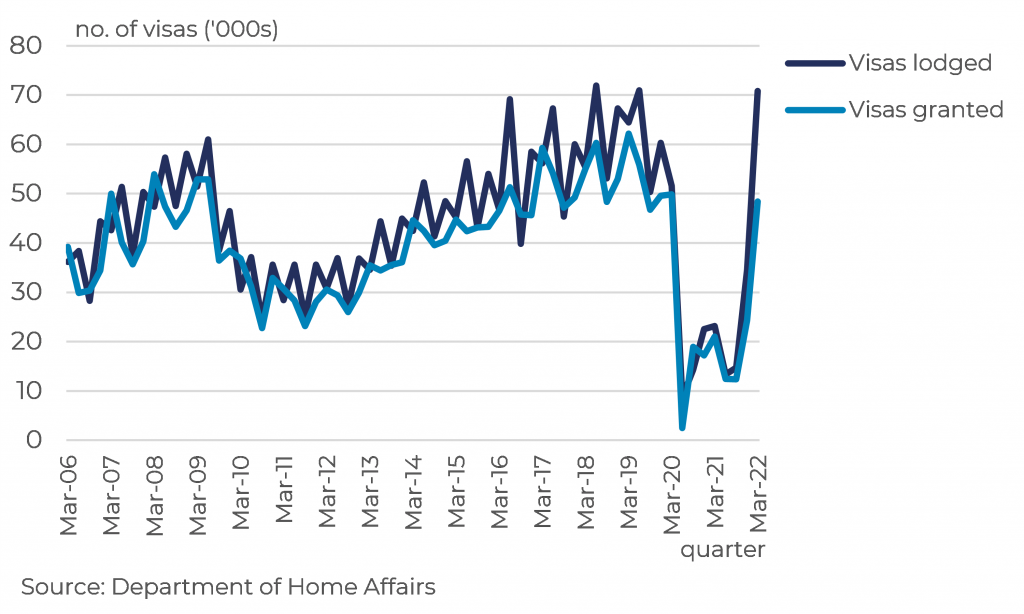Can the recovery in international student arrivals be sustained?
International students are the main driver of net overseas migration flows into Australia, and in pre-COVID times accounted for just over 40% of the country’s net overseas migration. Many international students move on to Temporary Graduate Visas and eventually become permanent residents.
The closure of Australia’s international borders through the COVID pandemic saw not only a substantial reduction in overseas student arrivals. The initial closure of borders at the onset of the pandemic just before the school year started in February/March 2020 saw many students ‘trapped’ overseas in their home country and unable to return. With little financial support through the economic lockdowns, many students also returned to their country of origin. Australia recorded a net migration outflow of just over 60,000 students in 2020/21, out of a total net overseas migration outflow of 88,760.
Overseas arrivals and departures data from the ABS suggests that student arrivals have surged since Australia’s borders were reopened in November 2021. An estimated 159,000 student visa holders entered the country in the twelve months to April 2022, with nearly all arriving since November 2021. This was just below the record 163,500 international student arrivals in 2018/19 and suggests that international student migration is bouncing back strongly.
Notably, much of this surge reflects offshore students entering (or re-entering) the country. Figure 1 highlights the close relationship between offshore student visas granted and international student arrivals. While there were nearly zero overseas student arrivals in 2020/21, some 69,600 student visas were still granted to students offshore, with many of these arriving for the 2022 student year.
Figure 1: Student arrivals vs student visas granted, Australia

Moreover, the reopening of international borders is driving an upswing in student visa lodgements and visas granted. Offshore Student visas granted rose to 97,500 in the year to March 2022, with the vast majority of these (73,000) granted in the latter six months of this period. The strength in visa grants follows an even stronger surge in visa lodgements. There were some 133,500 offshore student visa applications lodged in the twelve months to March 2022. This culminated in 70,800 lodgements in March quarter 2022, which is almost on par with the two highest quarters on record and points to further rises in student arrivals, likely into the second semester of 2022 (Figure 2).
Figure 2: Offshore student visas lodged and granted, Australia

Importantly, this rise in visa lodgements has brought about a change in the composition of students. Compared with June quarter 2019, there were a similar number of total visa lodgements, with Higher Education visa lodgements making up a similar majority. However, there were a significantly greater number of visa lodgements for Vocational Education and Training (VET) study and ELICOS (English language) study. The number of ELICOS lodgements, which is often a pathway to further study, was the highest on record, while the number of VET visas was the highest since 2009. Meanwhile, the number of non-award student visas and visas of other student categories are yet to recover.
While the strength in visa lodgements in March quarter 2022 is likely to represent pent up demand of students who may have delayed their study applications until borders reopened, the very strong level of VET and ELICOS (as well as Higher Education) visa lodgements is also likely to be a response to various government measures to attract international students in a post-COVID environment, including an easing of work restrictions on international students while they are studying.
Figure 3: Number of student visa applications lodged by student visa type

The trajectory of international student enrolments remains uncertain for now and will depend on whether the near-record level of visa lodgements seen in March quarter 2022 represents ‘pent up’ demand from students who have been waiting for borders to reopen before applying for a student visa or a very rapid return to sustained pre-COVID activity.
Nevertheless, the number of students that have already returned or are commencing study is expected to see overseas migration recover to a net inflow of over 40,000 in 2021/22, which is a turnaround of over 120,000 on the 80,000+ net outflow in 2020/21.
The growth trend should continue as the high level of student departures at the onset of the pandemic and subsequent low number of student arrivals in 2020/21 means that student departures over the next two to three years will be low. This will have an impact on the net increase in international students in Australia, whether there is a moderate recovery in international student arrivals or a rapid return to pre-COVID arrivals. Indeed, a rapid recovery to pre-COVID levels of international student arrivals is likely to result in the student component of net overseas migration reaching a new record, which in turn (depending on other overseas arrival categories) has the potential to drive record net overseas migration inflows in the coming years as well.


